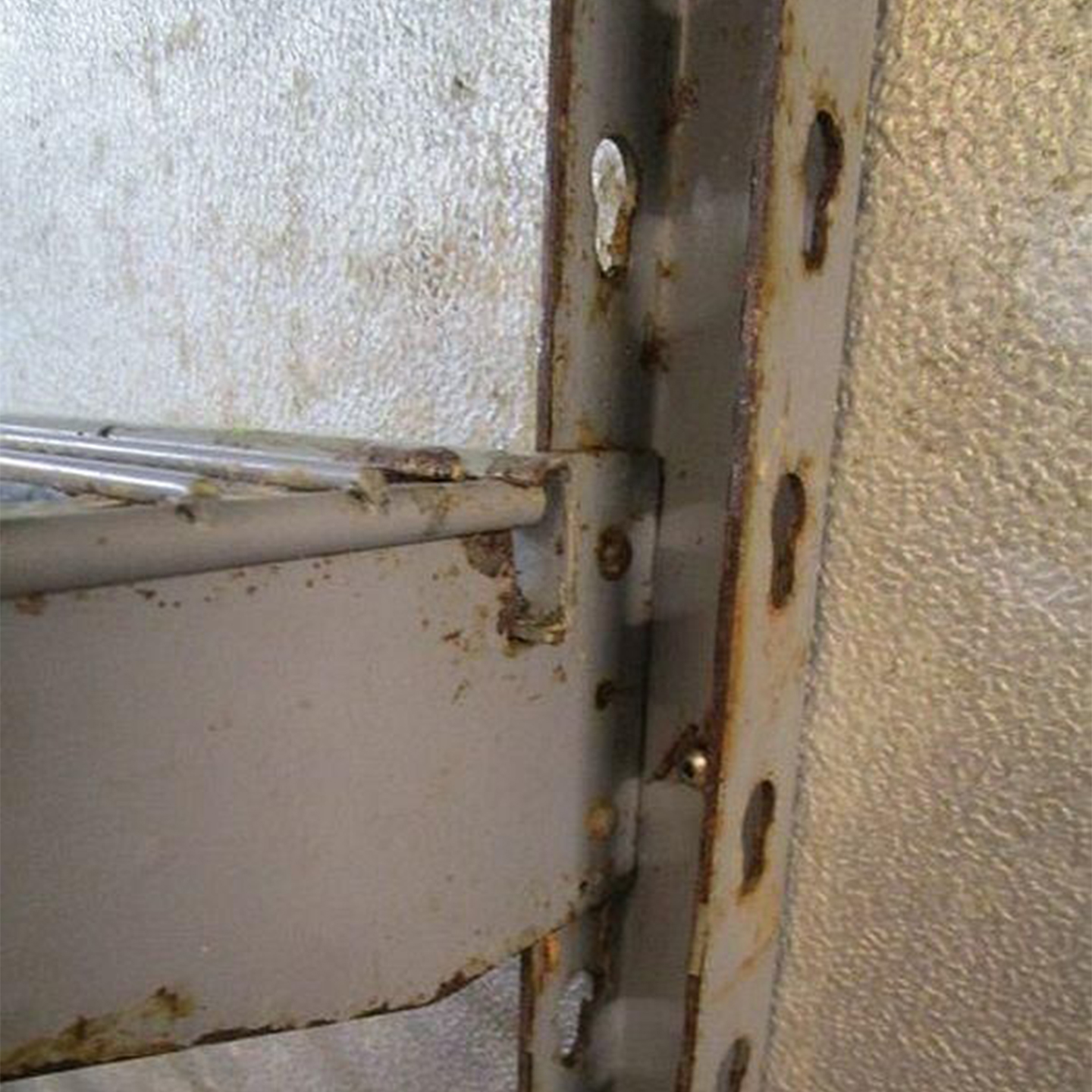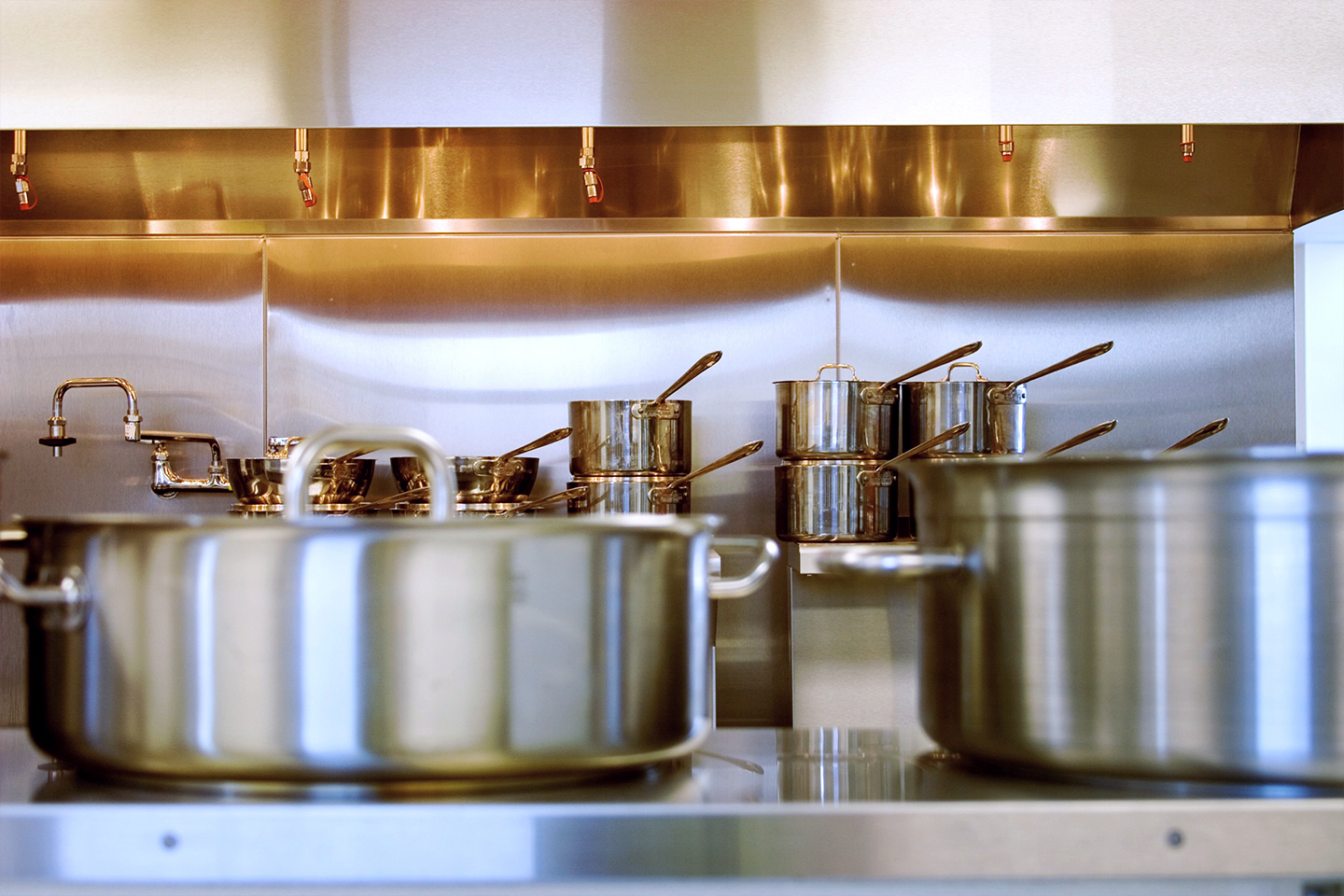Corrosion in your cooking space creates an unsanitary kitchen. Alloys that contain iron interact with oxygen to create what is known as rust, or iron oxide. Surfaces comprised of iron oxide are more difficult to clean because they contain nooks and small spaces for food and chemicals to get lodged in. As a result, the small spaces in, under and around rusted surfaces quickly become a breeding ground for bacteria.
Rust can be very costly to eradicate, and it can also negatively affect your score with the health inspector, who is already an expert at finding kitchen flaws. The last thing you want to worry about is the bacteria-infested rust on a shelf when preparing for inspection.
Food service environments have high sanitation requirements for every aspect of the kitchen. Meeting these requirements with your commercial storage is often burdensome for food service operators. This is because of the corrosive nature of many food and beverage products. And the cleaning products used to sanitize kitchens often exacerbate corrosion on commercial shelving.

When corrosion occurs, the potential for food contamination skyrockets, causing significant problems with both food quality and the inspector. Fortunately, food service equipment companies have created products to keep corrosion to a minimum in food storage and preparation spaces.
Zinc and Polymer Coated Steel Surfaces
Stainless steel equipment is a durable, corrosion-resistant material. This makes it a popular material for processing equipment, flooring, sinks, and food preparation surfaces such as worktables.
In some applications, various types of coatings are applied to stainless steel to enhance it’s natural resistance to corrosion. These steel coatings act as a corrosion shield. For instance, food service equipment that needs to resist harsh cleaners may have a coat of metallic zinc applied to add an extra layer of protection.
Additional topcoats include fluoropolymers and polyurethanes. Coatings made from food-grade polyurea get utilized on surfaces used for the preparation and production of food products. This particular type of coating creates a nonporous and smooth surface that eliminates holes, cracks, seams, or other areas where accumulations of food waste or pathogens can build up and corrode.
Because water and steam consistently hang in the air in restaurants, the potential for corrosion is continuously present. Using the best materials and coatings for a specific environment is essential to keeping corrosion from impacting the safety and quality of food on the prep line. Proper cleaning techniques are also crucial. However, food preparation and production surfaces are not the only places where attention should be given to corrosion prevention.
Plastic Shelving – Cold and Humid Storage

It’s easy to overlook food storage areas when trying to reduce corrosion in your restaurant. However, food storage areas such as walk-in coolers or freezers often come with the kind of high humidity levels that create an environment where rust and bacteria run rampant. Shelving for food product and ingredients can be especially challenging. Restaurant managers need commercial shelving with the following characteristics:
- Be strong enough to hold heavy food items for both long and short periods of time
- Shelves and storage that can be easily cleaned
- Have nonporous surfaces to help prevent pathogens and bacteria from collecting
Plastic shelving provides solutions to all three of these things, serving to greatly reduce corrosion.
Plastic or polymer shelving is an excellent solution to corrosion problems. Many plastic shelves have similar weight capacities to their metal counterparts and are just as effective at providing versatile storage solutions. They are perfect for wet and cold environments due to their unique material makeup and are incapable of decaying. This makes plastic and polymer shelves an ideal fit for your dish area or cooler.
Plastics are also convenient to clean and will not rust due to cleaners. You can run certain plastic and polymer shelves through the dishwasher, making them easier to keep clean and up to code. Always be sure to check first as some plastics are not dishwasher safe.
Dish Room Safety

Corrosion is also widespread in dishwashing areas. Your dishwashing area gets used all day, everyday. This generates a lot of steam and humidity. The area is always filled to the brim with wet dishes. If you don’t have the right equipment, this environment will generate corrosion on commercial equipment and drying racks.
The humid air isn’t the only thing causing corrosion as the dishes air dry. Dishes drip water, and if your warewashing shelving is not corrosion resilient, you’re shelving is going to quickly corrode and rust. Food service managers don’t want inspectors observing rusted shelves storing the clean dishes that will be used to serve customers food.
But there is good news. There are several corrosion-resistant options you can use for your drying rack needs. Shelving solutions such as polypropylene, plastic and epoxy ensure your humid-environment shelves are equipped to resist corrosion while your dishes dry. Epoxy-coated and plastic warewashing drying racks will save you headaches and money in the long run.
Having a properly designed drying rack ensures the safety of your guests by eliminating outside contaminants like rust and bacteria from wetnesting, providing a cleaner environment in the dishwashing area.
Happy Inspector, Happy Restaurant
As a food service operator, you have many storage options. The basic strategy is this: keep things clean. Use shelves and racks that resist humidity such as epoxy and plastic in your dishroom and coolers. Use stainless steel whenever possible and purchase equipment with zinc coatings when storing caustic materials. As with all things, strategic planing today will save you time and money tomorrow.



